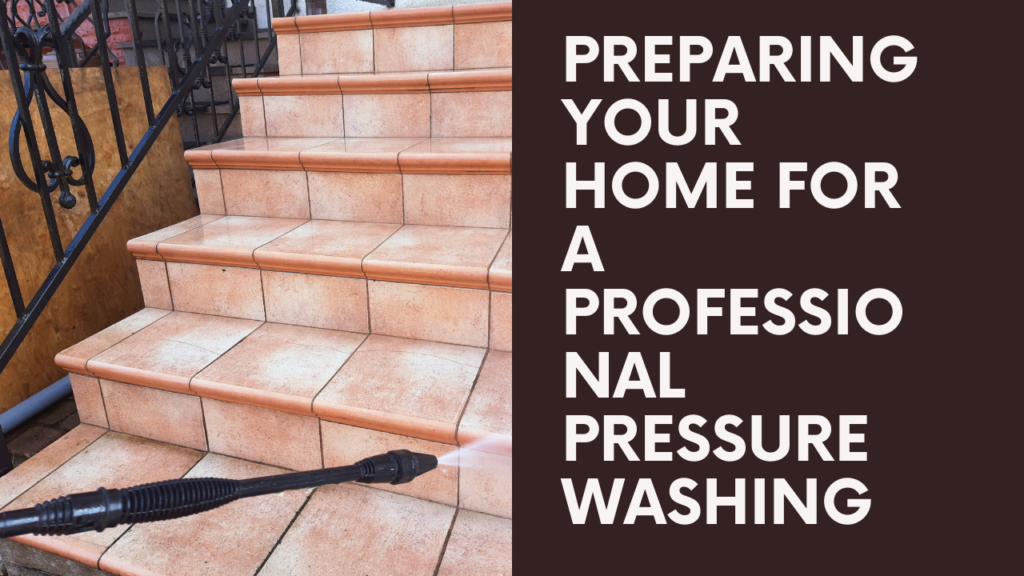Pressure washing is a highly effective method for maintaining your home’s exterior. It not only enhances curb appeal but also removes dirt, grime, mold, and other contaminants that can cause long-term damage. However, to ensure the best results, proper preparation is essential. This article will guide you through the necessary steps to prepare your home for a professional pressure washing service, helping you protect your property and maximize the benefits of this powerful cleaning technique.
I. Inspecting the Areas to Be Cleaned
Before the pressure washing service arrives, conduct a thorough inspection of your home’s exterior. Identifying sensitive areas will help you determine which parts of your home need special attention.
Begin by checking for vulnerable spots such as windows, doors, and vents. These areas are particularly susceptible to damage from the high-pressure water. Ensure all windows and doors are securely closed and sealed, especially if they are older or have visible cracks. Water infiltration through these openings can lead to mold growth or water damage inside your home.
Pay attention to any delicate plants or landscaping features near your home. If they are close to the areas being cleaned, consider covering them with tarps or moving potted plants to a safe location. Additionally, remove outdoor furniture, grills, and garden decorations from the cleaning zone. This not only protects these items but also allows the cleaning crew unobstructed access to all surfaces.
Inspect the exterior of your home for pre-existing damage. Look for loose siding, chipped paint, or cracks in concrete or brick surfaces. Documenting any existing issues with photos can help you compare the before and after condition of your home and address any potential problems with the cleaning service if necessary.
II. Clearing the Area
A clean and clear working environment allows the pressure washing team to perform their job efficiently and effectively. Begin by moving any outdoor furniture, grills, planters, or decorations away from the areas to be cleaned. This protects your belongings and provides the cleaning crew with unobstructed access to all surfaces.
If you have vehicles parked in your driveway or near the cleaning area, relocate them to a safe distance. This prevents accidental overspray or damage from the pressure washing. If moving vehicles is not an option, cover them with a protective tarp to shield them from any potential water or cleaning solution exposure.
Certain objects around your home may be difficult to move but still require protection. Cover delicate plants and landscaping features with breathable fabric or tarps to shield them from water and cleaning chemicals. Similarly, cover outdoor electrical outlets with plastic sheeting or waterproof covers to prevent water from entering and causing electrical issues. Decorative items like statues or fountains should also be covered to prevent damage from the pressure washing.
III. Protecting Your Home’s Exterior
To ensure that your home is fully protected during the pressure washing process, take additional steps to safeguard key areas.
Start by sealing all doors and windows. Check for any gaps or cracks around these openings and use weather stripping if necessary to ensure a tight seal. This prevents water from seeping into your home, which could cause damage to the interior.
Protect vents and electrical outlets by covering them with plastic sheeting or waterproof covers. This is particularly important for dryer vents, air intake vents, and other openings that lead directly into your home. For outdoor electrical components, cover light fixtures with plastic sheeting or waterproof covers to prevent damage from water exposure. If possible, turn off the power to these components during the pressure washing to reduce the risk of electrical damage.
IV. Communicating with the Professional Pressure Washing Team
Effective communication with the pressure washing team is key to ensuring a successful and stress-free experience.
Before the service begins, discuss any specific concerns or areas that require special attention. Inform the team about sensitive areas, such as delicate landscaping or older windows, and share any pre-existing damage you have identified. This helps the team take necessary precautions to avoid worsening any issues.
Set clear expectations by defining the scope of work and clarifying the cleaning methods and equipment to be used. Make sure both you and the team understand what areas will be cleaned and what level of cleaning is expected. Ask about the types of cleaning solutions that will be used and their impact on your property. If you have concerns about the environmental impact, inquire about eco-friendly options or request a patch test on a small, inconspicuous area.
V. Post-Pressure Washing Considerations
After the pressure washing is complete, take some time to inspect the results and ensure everything was cleaned to your satisfaction. Check for any missed spots or areas that may need additional cleaning. If you notice any issues, bring them to the attention of the cleaning team before they leave.
Handle the cleanup by removing protective coverings and replacing any relocated items. Finally, follow preventative maintenance tips to keep your home’s exterior clean and well-maintained after pressure washing. Regular upkeep can help extend the time between pressure washing services and maintain the appearance of your home.
By following these steps, you can ensure that your home is properly prepared for a professional pressure washing service. This not only protects your property but also helps the cleaning team achieve the best possible results, leaving your home looking refreshed and well-maintained.

